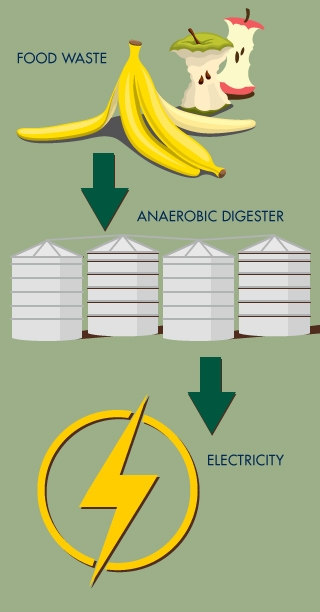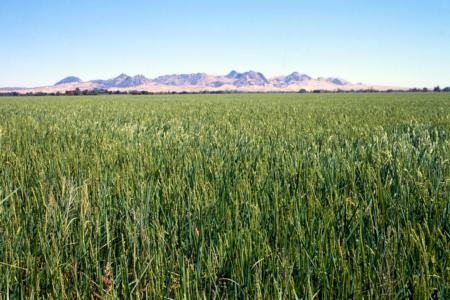Posts Tagged: greenhouse gas emissions
Biodigester turns campus waste into campus energy
Last week, on Earth Day, the university and Sacramento-based technology partner CleanWorld unveiled the UC Davis Renewable Energy Anaerobic Digester (READ) at the campus' former landfill. Here, the anaerobic digestion technology Zhang invented is being used inside large, white, oxygen-deprived tanks. Bacterial microbes in the tanks feast on campus and community food and yard waste, converting it into clean energy that feeds the campus electrical grid.
“This technology can change the way we manage our solid waste,” Zhang said. “It will allow us to be more economically and environmentally sustainable."
It is the third commercial biodigester CleanWorld has opened using Zhang's technology within the past two years and is the nation's largest anaerobic biodigester on a college campus.
The system is designed to convert 50 tons of organic waste to 12,000 kWh of renewable electricity each day using state-of-the-art generators, diverting 20,000 tons of waste from local landfills each year. It is expected to reduce greenhouse gas emissions by 13,500 tons per year.
The READ BioDigester encompasses several of the university's goals: reducing campus waste in a way that makes both economic and environmental sense, generating renewable energy, and transferring technology developed at UC Davis to the commercial marketplace.
The biodigester will enable the more than 100 million tons of organic waste each year that is currently being landfilled in the U.S. to be converted to clean energy and soil products. The READ BioDigester is a closed loop system, moving from farm to fork to fuel and back to farm. Whatever is not turned into biogas to generate renewable electricity can be used as fertilizer and soil amendments — 4 million gallons of it per year, which could provide natural fertilizers for an estimated 145 acres of farmlands each day.
Nearly half of the organic waste, or feedstock, needed to operate the biodigester to full benefit will come from UC Davis dining halls, animal facilities and grounds. CleanWorld is working with area food processing and distribution centers to supply the remaining amount. Meanwhile, UC Davis will earn 100 percent of the project's green energy and carbon credits and receive all of the electricity generated.
Anaerobic digestion is an age-old process. However, Zhang's patented technology made it more efficient — capable of eating a broader variety and bigger quantity of waste, turning it into clean energy faster and more consistently than other commercial anaerobic biodigesters.
View a video about the UC David biodigester here:
(This blog post is condensed from a UC Davis news release about the biodigester.)
Additional information:
- Read the full press release
- Download biodigester photos
- Vine video: From lunch to lights
- Visit http://www.cleanworld.com/
UC to measure energy and greenhouse gas footprints of orchard crops
A new study underway at the UC Sustainable Agriculture and Research and Education Program (SAREP) aims to help growers and policymakers better understand the energy use, greenhouse gas emissions, and carbon sequestration potential of orchard systems throughout California.
As trees grow, they draw carbon dioxide from the air to create sugar and cellulose for food and growth, locking some of that carbon into their wood as the trees age — in some trees for 25 years, in others like walnuts, for upwards of 150 years. Proper use of that carbon at the end of an orchard's life can have major implications for the overall greenhouse gas footprint of an orchard operation. Trees used for power generation after orchard removal have the potential to offset fossil-fuel related emissions created throughout the orchard's life.
"Our preliminary study in almonds shows that the amount of fossil fuel emissions saved in this way is equal to almost three-quarters of the greenhouse gas emissions generated during the whole 25-year lifespan of the orchard, using current practices," says the project's director, Sonja Brodt, SAREP academic coordinator. "We think that this information could help to position orchard crops favorably for a consumer base that is increasingly climate-smart."
This study, funded by the California Department of Food and Agriculture's Specialty Crops Block Grant Program, will focus on prunes, peaches, walnuts and almonds in all of the primary production regions of the state.
Many farm management practices have an energy use component that the project will consider including water and fertilizer use, tractor use and post-harvest transportation. By understanding which parts of orchard operations use the most energy as well as how much energy is required to manufacture and distribute inputs before they even arrive at the farm, growers can increase the efficiency of their practices. Industry groups can also develop more scientifically-sound grower sustainability programs to improve energy efficiency more broadly for the state's many tree crop growers.
"Energy is one input into agriculture that we have not thought about much from a whole supply chain point of view," says Gabriele Ludwig of the Almond Board of California, which funded a preliminary study on energy use and emissions in almond production and handling. "Yet the costs of energy, especially from fossil fuel sources, keep going up. The life cycle assessment approach used in this project can provide an analysis of where increased efficiencies may be possible."
The project's collaborators include the UC Cooperative Extension's Sutter-Yuba office, the UC Davis Department of Civil and Environmental Engineering, Department of Land, Air, and Water Resources, the Department of Plant Sciences, and graduate students in Horticulture and Agronomy and International Agricultural Development.
By working with growers throughout the state, project staff will be able to ensure that orchard management practices included in the project's models are representative of current practices. Growers interested in providing confidential input about their orchard practices are invited to contact Brodt at sbbrodt@ucdavis.edu or (530) 754-8547.
California rice growers reduce greenhouse gas emissions
Butler is participating in a pilot program funded by the Environmental Defense Fund. Though it’s too early to measure, he has seen promising signs from the project.
“We’ve had good results with yield and water conservation, which really was our goal,” says Butler. “We’re happy that greenhouse gases go down as a result of that, but they weren’t the initial reason why we do that.”
Of the global GHG accumulation for all sectors, 0.001 percent comes from California rice fields, according to data compiled by Luis Espino, UC Cooperative Extension rice farm advisor for Colusa County.
“It’s such a new issue I don’t think much has been done in that area,” says Espino. “Right now UC Davis is doing the research, doing the modeling, trying to understand what goes on in the soil.”
Cass Mutters, UC Cooperative Extension advisor for Butte County, noted that California rice growers realize that being environmentally sensitive is part of their responsibility. Since the 1980s, changes in irrigation management and other practices have led to a 98 percent reduction in pesticide residues entering public waterways from rice fields. Along with water quality, the rice industry supports an air quality monitoring network that enables the Air Resources Board to model how many acres can be burned without exceeding federal air quality standards.
Kaffka, partners awarded $2 million to develop biofuel
The Biodiesel Industries of Ventura was awarded $2 million grant for research and development of biodiesel fuel, according to a report by Marjorie Hernandez of the Ventura County Star.
Biodiesel Industries has partnered with Stephen Kaffka, director of the California Biomass Collaborative and UC Cooperative Extension specialist in the Department of Plant Sciences at UC Davis.
Kaffka will conduct research to develop viable biofuel feedstocks at test plots at UC Davis and in Salinas, the Imperial Valley and Five Points in the Central Valley, according to the article.
Biodico President Russell Teall said, "The goal is to develop innovative solar cogeneration, anaerobic digestion and gasification. While Dr. Kaffka will look at the agronomics, Diener will take those results and use them in a larger context. We will be able to take biomass, which can be gasified and used to make heat and power that will provide a very clean form of combustion."
Teall said the project should start in June, with various equipment in place by August or September.





